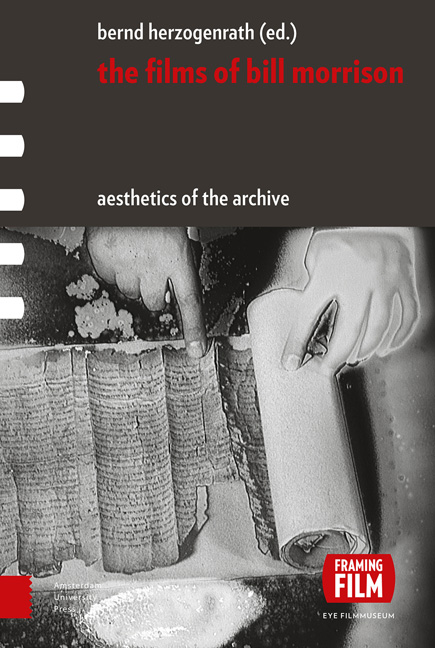Book contents
- Frontmatter
- Contents
- Acknowledgments
- Aesthetics of the Archive: An Introduction
- Chapter 1 Drafts and Fragments: Reflections around Bill Morrison and the Paper Print Collection
- Chapter 2 The Film of Her: The Cine-Poet Laureate of Orphan Films
- Chapter 3 Ghost Trip: Searching for Potential Myths
- Chapter 4 Decasia: The Matter | Image: Film is also a Thing
- Chapter 5 The Mesmerist: Illustrating the Return of the Repressed
- Chapter 6 Light is Calling: Celluloid Dreams
- Chapter 7 Gotham: Zoetrope: Block by Block
- Chapter 8 Outerborough: Early Cinema Revisited
- Chapter 9 The Highwater Trilogy: Thinking the Liquid – On the Ethics of Water and the Material Ecologies of Disaster and Ruination
- Chapter 10 Porch: Archives, Collective Memory, and the Poetics of Home Movies
- Chapter 11 The Future Lasts Long: The Romanov Lost Family Archives
- Chapter 12 Who by Water: Variations on Matter, Figures, Memory, and Mythology
- Chapter 13 Every Stop on the F-Train: Beyond and within the Restless Netherworld of (Manhattan’s) Mind
- Chapter 14 Spark of Being: Bachelor Machine
- Chapter 15 The Miners’ Hymns: Acts of Resurrection
- Chapter 16 Tributes – Pulse: A Requiem for the 20th Century: Death | Drive | Image
- Chapter 17 Just Ancient Loops: The Loops of Life in Intonation
- Chapter 18 The Great Flood: Water is Transparence Derived from the Presence of Everything
- Chapter 19 Re-Awakenings: Bill Morrison in Conversation
- Index of Film Titles
- Index of Names
- Index of Subjects
- Already Published
Chapter 3 - Ghost Trip: Searching for Potential Myths
Published online by Cambridge University Press: 12 December 2020
- Frontmatter
- Contents
- Acknowledgments
- Aesthetics of the Archive: An Introduction
- Chapter 1 Drafts and Fragments: Reflections around Bill Morrison and the Paper Print Collection
- Chapter 2 The Film of Her: The Cine-Poet Laureate of Orphan Films
- Chapter 3 Ghost Trip: Searching for Potential Myths
- Chapter 4 Decasia: The Matter | Image: Film is also a Thing
- Chapter 5 The Mesmerist: Illustrating the Return of the Repressed
- Chapter 6 Light is Calling: Celluloid Dreams
- Chapter 7 Gotham: Zoetrope: Block by Block
- Chapter 8 Outerborough: Early Cinema Revisited
- Chapter 9 The Highwater Trilogy: Thinking the Liquid – On the Ethics of Water and the Material Ecologies of Disaster and Ruination
- Chapter 10 Porch: Archives, Collective Memory, and the Poetics of Home Movies
- Chapter 11 The Future Lasts Long: The Romanov Lost Family Archives
- Chapter 12 Who by Water: Variations on Matter, Figures, Memory, and Mythology
- Chapter 13 Every Stop on the F-Train: Beyond and within the Restless Netherworld of (Manhattan’s) Mind
- Chapter 14 Spark of Being: Bachelor Machine
- Chapter 15 The Miners’ Hymns: Acts of Resurrection
- Chapter 16 Tributes – Pulse: A Requiem for the 20th Century: Death | Drive | Image
- Chapter 17 Just Ancient Loops: The Loops of Life in Intonation
- Chapter 18 The Great Flood: Water is Transparence Derived from the Presence of Everything
- Chapter 19 Re-Awakenings: Bill Morrison in Conversation
- Index of Film Titles
- Index of Names
- Index of Subjects
- Already Published
Summary
ABSTRACT
The concept of the ‘trip’ can have two meanings: one describes a mental transformation of being (a hallucinatory state caused by drugs), while the other covers the idea of an indefinite itinerary, which is associated with the English word road. By its structure, Ghost Trip (2000) literally embarks on an unknown and sinuous quest. The movie is, per se, a strange object, the story follows the mysterious itinerary of a man who searches for myths in a landscape of undisclosed experiences. Starting with its formal structure, this essay explores the mythical stories that are implied in the images of Morrison's film and tackles the question of how Ghost Trip portrays an existential void that embraces the search for the essence of things.
KEYWORDS
frame, hyperreality, myth, ritual
Time is dead as long as it is being clicked off by little wheels; only when the clock stops does time come to life.
– William Faulkner, The Sound and the FuryTHE TRIP-BALLAD FORM AND CIRCULARITY
The theme of the trip is not specific to Ghost Trip, but also resonates in other films by Bill Morrison, such as City Walk (1999) or The East River (2003). City Walk is about an urban imaginary world that gives the impression of a stark landscape. The frame is marked by a sooty chiaroscuro, which suggests an oppressing and austere mood. The director constantly manipulates the image through intensive work on the medium: the black-and-white images begin with white vertical scratches, which give way to manipulated shots. It is difficult to know how Morrison uses this manipulation: while shooting or during the editing process (on an optical printer). In The East River, the journey is more subjective. It is as if the spectator becomes the character himself, moving in water. The movie makes an aesthetic use of colour through a work on the saturation and its indistinctive resulting tint. Consequently, the droplets on the camera's lens give it a pictorial, pointillist vibration. In this context, Ghost Trip appears as a distinctive movie in Bill Morrison's work. The film depicts a fictional world instead of following the practice of his found-footage experiments. The first shot opens on a cemetery where a man puts some roses on a grave.
- Type
- Chapter
- Information
- The Films of Bill MorrisonAesthetics of the Archive, pp. 69 - 82Publisher: Amsterdam University PressPrint publication year: 2017



